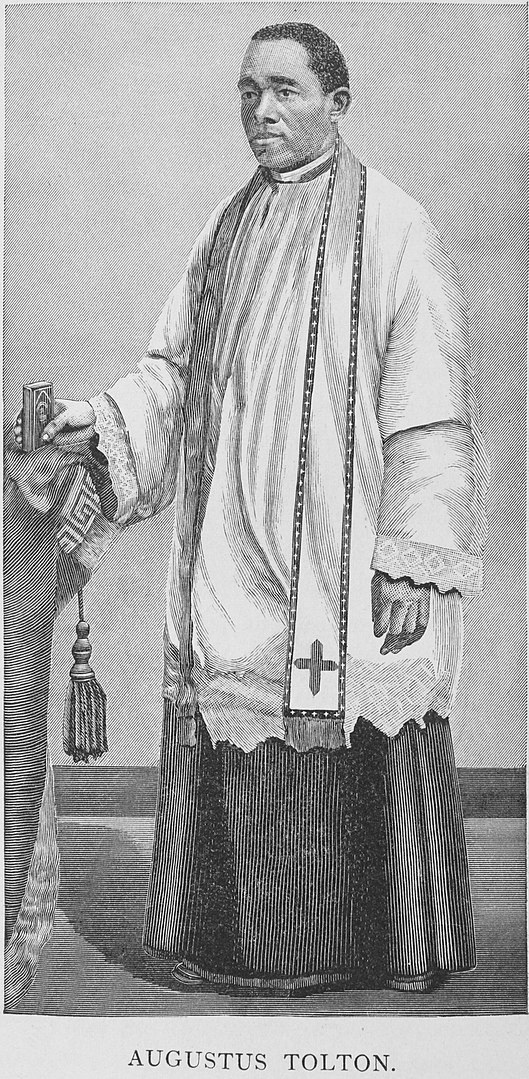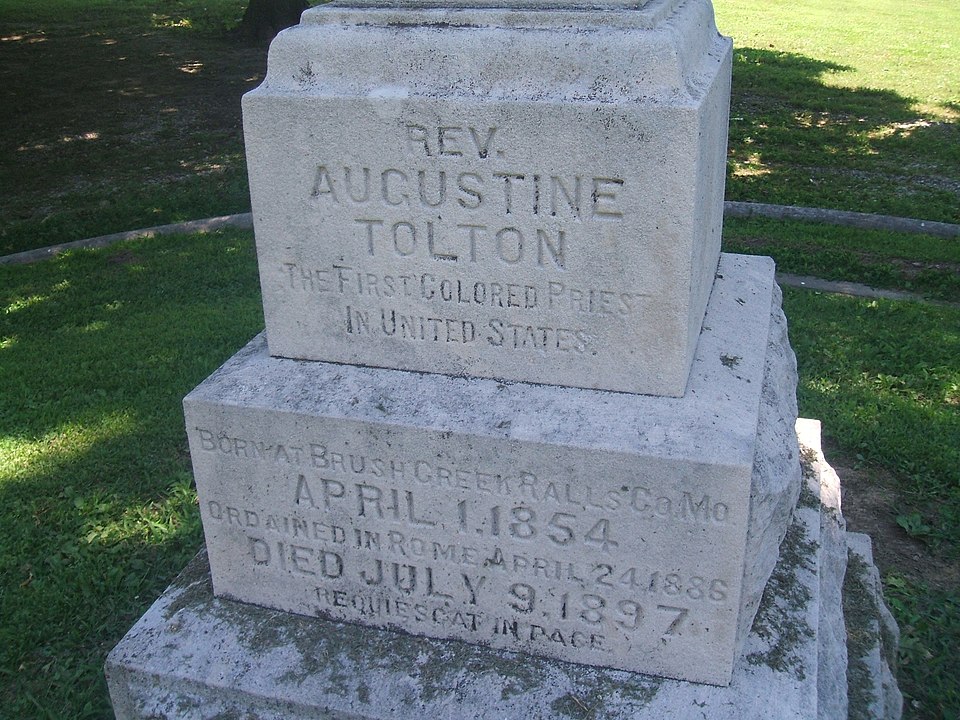 In 2010 the Archdiocese of Chicago opened the cause for canonization for Fr. Augustus Tolton, the first African-American priest in the United States. On June 11, 2019 Pope Francis issued a “Decree of Heroic Virtue,” thus advancing the cause of Fr. Tolton and granting him the title of “Venerable.”
In 2010 the Archdiocese of Chicago opened the cause for canonization for Fr. Augustus Tolton, the first African-American priest in the United States. On June 11, 2019 Pope Francis issued a “Decree of Heroic Virtue,” thus advancing the cause of Fr. Tolton and granting him the title of “Venerable.”
A lot has been written about Fr. Tolton’s life, including the fact that he was born a slave in Missouri and escaped with his mother and siblings into Illinois during the Civil War. He was educated in Quincy, Illinois and through the assistance of several local priests, he was accepted into the seminary at the Propaganda Fide in Rome. Fr. Tolton was ordained in 1886 and returned to Quincy as the pastor of St. Joseph’s Church. He proved to be a popular pastor and soon attracted the ire of the pastor of St. Boniface Church. In 1889, he left Quincy for Chicago and remained there until his death in 1897.
Many of Fr. Tolton’s biographies mention that he was taught by the School Sisters of Notre Dame, but little is written about these women beyond the fact that they staffed the schools he attended. Very few of Fr. Tolton’s speeches and letters exist, but in a speech given at the First Black Catholic Congress in Washington, D.C. in 1889, he provides some insight into how one particular SSND affected his life and vocation:
“The Catholic Church deplores a double slavery – that of the mind and that of the body. She endeavors to free us both. I was a poor slave boy but the priests of the Church did not disdain me. It was through the influence of one of them that I became what I am tonight. I must now give praise to that son of the Emerald Isle, Father Peter McGirr, pastor of St. Peter’s Church in Quincy, who promised me that I would be educated and kept his word. It was the priests of the Church who taught me to pray and to forgive my persecutors…it was through the direction of a Sister of Notre Dame, Sister Herlinde, that I learned to interpret the Ten Commandments; and then I also beheld for the first time the glimmering light of truth and the majesty of the Church. In this Church we do not have to fight for our rights because we are black. She had colored saints – Augustine, Benedict the Moor, Monica. The Church is broad and liberal. She is the Church for our people.”
Sr. Herlinda Sick
Maria Sick was born in Philadelphia on August 8, 1840. It is not known why she chose to enter religious life, but in 1860 she travelled to Milwaukee to join the School Sisters of Notre Dame. On August 22, 1866 she was accepted into the novitiate and was given the religious name of Sr. Herlinda.
In 1867, Sr. Herlinda was assigned to teach the second division at St. Mary’s Institute in Quincy, Illinois. The following year she was transferred to St. Lawrence School (changed to St. Peter in 1869).
That same year, Fr. Peter McGirr, pastor of St. Lawrence, made arrangements for Augustus to attend the parish school and Sr. Herlinda was given the task of providing him with additional instruction after school. For the next few years, Augustus attended St. Peter’s School for several months and then would return to work in a local tobacco factory when it opened for the season. He later spoke fondly of his time at the school, saying: “As long as I was in that school I was safe. Everyone was kind to me. I learned the alphabet, spelling, reading and arithmetic.”
In December 1876, Sr. Herlinda left the school for a short time due to illness and in 1881, she professed her final vows.
In October 1877, the Franciscan Fathers at Quincy College opened a Sunday school for the black children in Quincy. Attendance grew throughout the winter and the idea of opening a day school grew in popularity. The priest contacted Mother Caroline Friess, the Vicar General for the SSND in North America, and she agreed to send a Sister to staff the school. On February 7, 1878, Sr. Herlinda opened St. Joseph’s School with 21 children.
Despite a hopeful beginning, the school was plagued with issues. In April 1878, seven children from St. Joseph were baptized and members of the Methodist and Baptist churches protested this action and insisted that all black children in Quincy attend public school. Some of the children were compelled to leave, but others came in their place.
In 1880, the Franciscans received word that they had to close the school, but they made an agreement with the priest at St. Boniface, who agreed to assume responsibility for St. Joseph. Sr. Herlinda had already been assigned to a school in Kentucky, but was recalled and went back to work with the children at St. Joseph’s.
 In 1886, Fr. Tolton was ordained and he was assigned to take over as pastor at St. Joseph’s Church in Quincy. He quickly gained a reputation as a good homilist and whites from other parishes began to attend Mass at St. Joseph. In 1887, Fr. Michael Weiss was installed at St. Boniface and he was not happy to learn that many of his parishioners were financially supporting Fr. Tolton’s church. Fr. Weiss believed that Fr. Tolton should only minister to blacks and should tell whites to stay away from his church. The bishop eventually intervened and sided with Fr. Weiss, informing Fr. Tolton that he was to minister to black people only.
In 1886, Fr. Tolton was ordained and he was assigned to take over as pastor at St. Joseph’s Church in Quincy. He quickly gained a reputation as a good homilist and whites from other parishes began to attend Mass at St. Joseph. In 1887, Fr. Michael Weiss was installed at St. Boniface and he was not happy to learn that many of his parishioners were financially supporting Fr. Tolton’s church. Fr. Weiss believed that Fr. Tolton should only minister to blacks and should tell whites to stay away from his church. The bishop eventually intervened and sided with Fr. Weiss, informing Fr. Tolton that he was to minister to black people only.
The situation was unbearable for Fr. Tolton and in 1889 he wrote to his superior in Rome, stating, “I beg you to give me permission to go to the diocese of Chicago. It is not possible for me to remain here any longer with this German priest.” His request was granted and in 1889, he was installed as the pastor at St. Monica’s Church in Chicago.
Meanwhile at the school, Sr. Herlinda struggled as well. The average attendance of the school was 60 students and though many were baptized, few persevered as members of the Catholic faith. Most of the children who attended the school were poor and Sr. Herlinda learned that some of the children only attended school to stay warm in the winter. She helped to provide shoes, clothing and sometimes food for the poorest of the students. She was also suffering from a heart ailment. In 1888, she was forced to leave St. Joseph’s because she was no longer able to walk the three blocks from the convent to the school. Another Sister was sent to replace her, but shortly after she arrived, the school closed.
After leaving Quincy, Sr. Herlinda went to St. Mary’s in Annapolis where she was put in charge of a class with 20 black students. However, the climate did not agree with her and she left after a few days. On October 8, 1888 she took charge of one of the classes at St. Joseph’s Orphanage in Manhattan.
In June 1892, Sr. Herlinda, who had been suffering from a heart ailment for several years, returned to the convent and was completely exhausted. At first the doctor did not think her condition was serious, but soon it became clear that “she had to be relieved of any stress.” She deteriorated throughout the night and she died on the morning of June 22, 1892 at the age of 51.
Her obituary stated that she “labored with untiring zeal for many years in the Negro school in Quincy, Illinois.” What it does not say, is that she helped educate and shape a child, who would one day be given the title of Venerable.
For more information about the Venerable Fr. Augustus Tolton, including a more detailed biography and information about his cause for canonization, see: https://tolton.archchicago.org/
